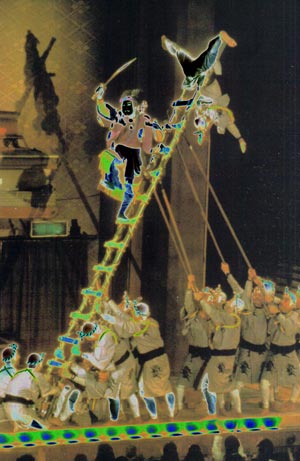| ZAÔDÔ |
| Play title | Yoshitsune Senbon Zakura Yoshitsune and the Thousand Cherry Trees |
| Authors | Takeda Izumo II Miyoshi Shôraku Namiki Senryû I |
| History |
The play "Yoshitsune Senbon Zakura" was originally written for the puppet theater (Bunraku) and staged for the first time in the 11th lunar month of 1747 in Ôsaka at the Takemotoza. It was adapted for Kabuki the following year and staged for the first time in the 1st lunar month of 1748 in Ise with Kataoka Nizaemon IV (Tokaiya Ginpei, Yokawa no Zenji Kakuhan) and Yamamoto Koheiji (Tadanobu). It was performed for the first time in a city licensed theater in the 5th lunar month of 1748, in Edo at the Nakamuraza [casting]. The fifth act of "Yoshitsune Senbon Zakura" was never staged in Kabuki. The stage giant Ichikawa Ennosuke III decided to add it in the tôshi kyôgen production of "Yoshitsune Senbon Zakura", which was staged in July 1980 at the Kabukiza. This new 5th act was a spectacular tachimawari [more details]. |
| Structure |
The "Zaôdô Hanayagura" scene is the only scene of the 5th act of "Yoshitsune Senbon Zakura". It is commonly called "Zaôdô". |
| Key words |
Genpei Kassen Genpei-kassenmono Genji Gidayû Kyôgen Giri/Ninjô Hanayagura Heike Jidaimono Minamoto Yoritomo Minamoto Yoshitsune Noto-no-Kami Noritsune Tachimawari Taira Noritsune Yoshinoyama Zaôdô |
| Summary |
Previous scene: "Okuniwa" Zaôdô Hanayagura As is quite standard for Japanese traditional dramas, the final act is short, swift, and serves to wrap up any major loose plot threads. Here, it opens on a mountaintop, with Tadanobu, dressed as Yoshitsune, calling out a challenge to those who side with Yoritomo and the Shogunate. A number of warriors come at him, and he cuts them down. Noritsune then appears, as the monk Kakuhan, who claims to have foregone all his old grudges, and his warrior ways. Tadanobu declares his true identity to his foe, and the two clash in a complex choreographed fight scene. Finally, Noritsune pins his opponent to the ground, but a second Tadanobu rushes in and stabs the Heike general, the body below him disappearing and leaving only a suit of armor. Yoshitsune explains that they saw through Noritsune's promises of peace, and the fox Genkurô aided them in subduing him. Kawagoe, an agent of the Shogunate, then appears, along with Fujiwara no Tomokata, who he has tied up. He reveals that the Imperial order which came with the drum, ordering Yoshitsune to oppose his brother, along with that to exterminate the Taira clan, came not from the Emperor, but from the machinations of Tomokata. Hearing this, Noritsune kills the defenseless Tomokata, and then turns to Yoshitsune, challenging his foe to kill him. Yoshitsune states that Noritsune died long ago, that he has since become Kakuhan, and that it is to Tadanobu to kill him. The play thus ends with the last of Yoshitsune's foes slain, and a return to the peace and auspiciousness with which the play began. Source: Wikipedia |
 |
||
|
Fighting on the hanamichi (a digital painting made by Shôriya Araemon in 2010) |
||
|
|
| Contact | Main | Top | Updates | Actors | Plays | Playwrights | Programs | Links | FAQ | Glossary | Chronology | Illustrations | Prints | Characters | Derivatives | Theaters | Coming soon | News |